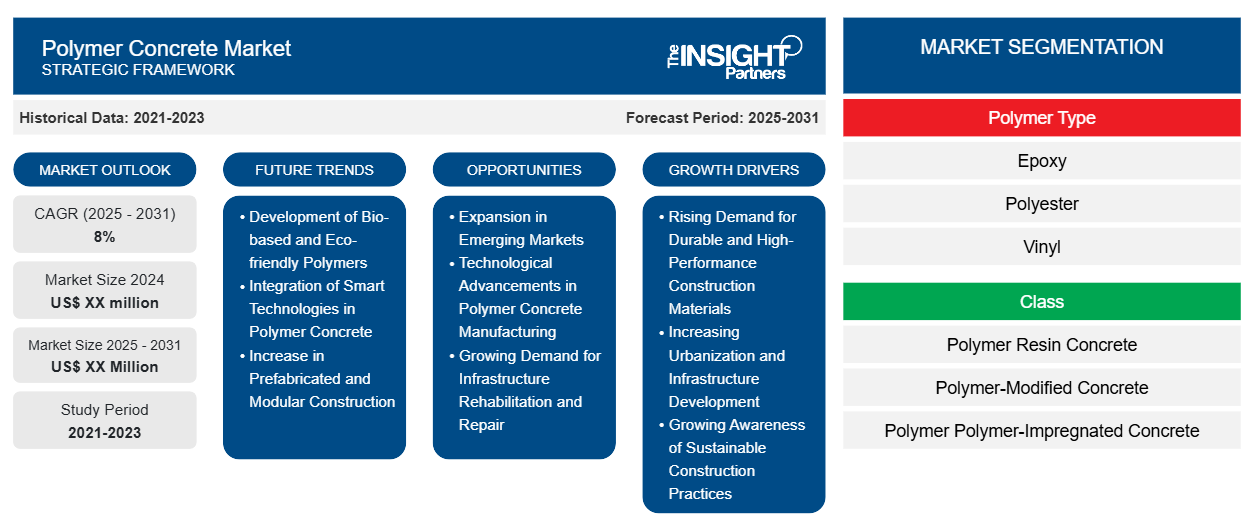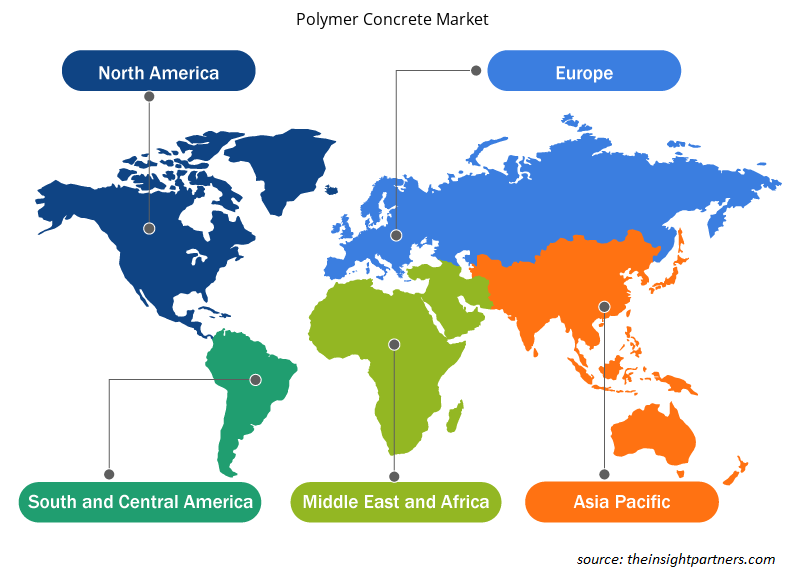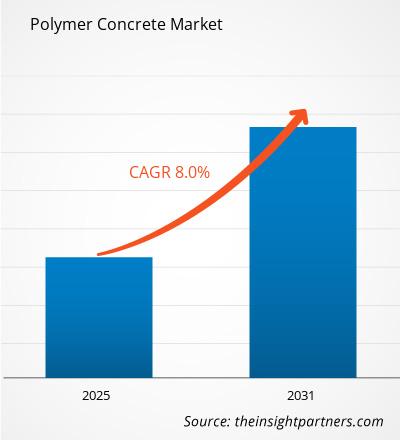The Polymer Concrete Market is expected to register a CAGR of 8% from 2025 to 2031, with a market size expanding from US$ XX million in 2024 to US$ XX Million by 2031.
Polymer Concrete Market Size and Forecasts (2021 - 2031), Global and Regional Share, Trend, and Growth Opportunity Analysis by Polymer Type (Epoxy, Polyester, Vinyl, Acrylate and Others), Class (Polymer Resin Concrete (PC), Polymer-Modified Concrete (PMC), and Polymer Polymer-Impregnated Concrete (PIC)), Binding Agents (Natural Resin, and Synthetic Resin), and Application (Containments, Pump Bases, Waste Containers, Flooring Blocks, and Others.). The global polymer concrete market is anticipated to register a CAGR of 7.7%. The growth in the construction sector has aided to growth of the polymer market. Polymer concrete offers several advantages over traditional concrete, increasing the popularity of polymer concrete in nuclear power plants, and others.
Purpose of the Report
The report Polymer Concrete Market by The Insight Partners aims to describe the present landscape and future growth, top driving factors, challenges, and opportunities. This will provide insights to various business stakeholders, such as:
- Technology Providers/Manufacturers: To understand the evolving market dynamics and know the potential growth opportunities, enabling them to make informed strategic decisions.
- Investors: To conduct a comprehensive trend analysis regarding the market growth rate, market financial projections, and opportunities that exist across the value chain.
- Regulatory bodies: To regulate policies and police activities in the market with the aim of minimizing abuse, preserving investor trust and confidence, and upholding the integrity and stability of the market.
Polymer Concrete Market Segmentation
Polymer Type
- Epoxy
- Polyester
- Vinyl
- Acrylate
Class
- Polymer Resin Concrete
- Polymer-Modified Concrete
- Polymer Polymer-Impregnated Concrete
You will get customization on any report - free of charge - including parts of this report, or country-level analysis, Excel Data pack, as well as avail great offers and discounts for start-ups & universities
Polymer Concrete Market: Strategic Insights

- Get Top Key Market Trends of this report.This FREE sample will include data analysis, ranging from market trends to estimates and forecasts.
Polymer Concrete Market Growth Drivers
- Rising Demand for Durable and High-Performance Construction Materials: One of the primary drivers of the global polymer concrete market is the increasing demand for durable, high-performance construction materials. Polymer concrete, known for its superior mechanical properties, is resistant to chemicals, moisture, and environmental stress, making it an ideal choice for infrastructure and construction projects. It is used in various applications, such as roads, bridges, industrial flooring, and wastewater treatment plants, where conventional concrete may not provide the required durability or resistance. The growing need for longer-lasting and more reliable construction materials is driving the adoption of polymer concrete.
- Increasing Urbanization and Infrastructure Development: Rapid urbanization and the expansion of infrastructure in developing economies are also fueling the growth of the polymer concrete market. As cities grow and industrialization progresses, there is an increasing demand for infrastructure projects like highways, buildings, bridges, and tunnels. Polymer concrete's ability to withstand harsh environments and its superior longevity make it an attractive choice for such large-scale projects. Additionally, polymer concrete is used in repairing and reinforcing existing structures, which is essential for maintaining aging infrastructure in urban areas. These factors contribute to the market's expansion.
- Growing Awareness of Sustainable Construction Practices: The growing emphasis on sustainable and environmentally friendly construction practices is another significant driver for the polymer concrete market. Polymer concrete is often considered more sustainable compared to traditional concrete due to its reduced environmental footprint. It can incorporate recycled materials, has a lower carbon footprint during production, and offers energy efficiency benefits in its applications. The global shift towards green building initiatives, including LEED (Leadership in Energy and Environmental Design) certification, is encouraging the use of polymer concrete as a sustainable alternative for construction projects, boosting its demand.
Polymer Concrete Market Future Trends
- Development of Bio-based and Eco-friendly Polymers: One of the key future trends in the polymer concrete market is the development of bio-based and eco-friendly polymers. As the construction industry increasingly shifts towards sustainability, the need for environmentally friendly materials is rising. Manufacturers are focusing on the development of polymer concrete formulations using bio-based or recycled polymers, reducing the reliance on petrochemical-based products. These eco-friendly polymer concretes will not only address environmental concerns but also comply with the growing regulatory standards aimed at reducing the carbon footprint of construction materials.
- Integration of Smart Technologies in Polymer Concrete: The integration of smart technologies into construction materials is an emerging trend that is expected to impact the polymer concrete market. Smart polymer concrete, equipped with sensors, is being developed to monitor factors such as temperature, humidity, strain, and cracks in real-time. These smart materials can provide early warning signs of structural failures, enabling proactive maintenance and improving the lifespan of infrastructure. As the demand for intelligent infrastructure grows, smart polymer concrete is likely to see increasing adoption in applications such as bridges, highways, and industrial floors, where maintenance and durability are crucial.
- Increase in Prefabricated and Modular Construction: The trend towards prefabricated and modular construction is expected to drive the demand for polymer concrete in the future. Prefabricated concrete panels and elements, which can be produced in controlled factory settings and then assembled on-site, benefit from the use of polymer concrete due to its high strength-to-weight ratio, ease of molding, and durability. As modular construction techniques gain popularity for their cost-efficiency and speed, the demand for polymer concrete solutions in pre-made construction components will continue to grow, contributing to market growth.
Polymer Concrete Market Opportunities
- Expansion in Emerging Markets: Emerging economies, particularly in Asia-Pacific, Africa, and Latin America, present significant opportunities for the global polymer concrete market. With rapid urbanization, increased construction activities, and rising infrastructure demands in these regions, polymer concrete’s advantages of enhanced durability and resistance to harsh environmental conditions make it an attractive choice for infrastructure development. The growth of industrial sectors in these regions also creates demand for high-performance materials like polymer concrete, providing a significant market opportunity for manufacturers.
- Technological Advancements in Polymer Concrete Manufacturing: Technological advancements in the manufacturing processes of polymer concrete provide an opportunity to reduce production costs and improve product performance. Innovations such as the development of automated mixing systems, optimized curing methods, and the introduction of advanced polymer composites are enhancing the production capabilities of polymer concrete. These advancements can help manufacturers produce polymer concrete at scale, lower production costs, and improve material properties such as flexibility, crack resistance, and thermal stability. These developments will open up new applications for polymer concrete and drive its market growth.
- Growing Demand for Infrastructure Rehabilitation and Repair: Another opportunity in the polymer concrete market lies in the growing demand for infrastructure rehabilitation and repair. Many developed nations face aging infrastructure, including bridges, tunnels, and roadways, which require maintenance and reinforcement. Polymer concrete’s ability to repair and reinforce damaged or deteriorating concrete structures is a key advantage, particularly in critical infrastructure sectors. As governments and private entities invest in upgrading and maintaining aging infrastructure, the demand for polymer concrete solutions for repair, reinforcement, and restoration is expected to rise, providing a significant opportunity for market growth.
Polymer Concrete Market Regional Insights
The regional trends and factors influencing the Polymer Concrete Market throughout the forecast period have been thoroughly explained by the analysts at The Insight Partners. This section also discusses Polymer Concrete Market segments and geography across North America, Europe, Asia Pacific, Middle East and Africa, and South and Central America.

- Get the Regional Specific Data for Polymer Concrete Market
Polymer Concrete Market Report Scope
| Report Attribute | Details |
|---|---|
| Market size in 2024 | US$ XX million |
| Market Size by 2031 | US$ XX Million |
| Global CAGR (2025 - 2031) | 8% |
| Historical Data | 2021-2023 |
| Forecast period | 2025-2031 |
| Segments Covered |
By Polymer Type
|
| Regions and Countries Covered | North America
|
| Market leaders and key company profiles |
Polymer Concrete Market Players Density: Understanding Its Impact on Business Dynamics
The Polymer Concrete Market is growing rapidly, driven by increasing end-user demand due to factors such as evolving consumer preferences, technological advancements, and greater awareness of the product's benefits. As demand rises, businesses are expanding their offerings, innovating to meet consumer needs, and capitalizing on emerging trends, which further fuels market growth.
Market players density refers to the distribution of firms or companies operating within a particular market or industry. It indicates how many competitors (market players) are present in a given market space relative to its size or total market value.
Major Companies operating in the Polymer Concrete Market are:
- BASF SE
- Sika AG
- The Dow Chemical Company
- Dudick Inc
- Sauereisen
- Kwik Bond Polymers
Disclaimer: The companies listed above are not ranked in any particular order.

- Get the Polymer Concrete Market top key players overview
Key Selling Points
- Comprehensive Coverage: The report comprehensively covers the analysis of products, services, types, and end users of the Polymer Concrete Market, providing a holistic landscape.
- Expert Analysis: The report is compiled based on the in-depth understanding of industry experts and analysts.
- Up-to-date Information: The report assures business relevance due to its coverage of recent information and data trends.
- Customization Options: This report can be customized to cater to specific client requirements and suit the business strategies aptly.
The research report on the Polymer Concrete Market can, therefore, help spearhead the trail of decoding and understanding the industry scenario and growth prospects. Although there can be a few valid concerns, the overall benefits of this report tend to outweigh the disadvantages.
Frequently Asked Questions
What are the future trends in the market?
Growing demand for aesthetics is an emerging trend in the market
Which polymer type segment accounted for the highest share in the polymer concrete market?
The epoxy polymer type segment accounted for the largest market share in 2023.
Based on geography, which region is expected to record a highest CAGR in the market.
The North America market is expected to account for the highest CAGR during the forecast period owing to the growing construction projects in the region.
What are the driving factors impacting the polymer concrete market?
Growing demand for construction industry is a key driver in the market
What are the key players operating in the polymer concrete market?
BASF SE, Sika AG, The Dow Chemical Company, Dudick Inc, Sauereisen, Kwik Bond Polymers, Fosroc International Ltd, Crown Polymers Corporation, BaseTek, and Hubbell, Inc. are some of the key players in the market.
What is the expected CAGR of the Polymer Concrete Market?
The Polymer Concrete Market is estimated to witness a CAGR of 8% from 2023 to 2031
- Historical Analysis (2 Years), Base Year, Forecast (7 Years) with CAGR
- PEST and SWOT Analysis
- Market Size Value / Volume - Global, Regional, Country
- Industry and Competitive Landscape
- Excel Dataset
Testimonials
Reason to Buy
- Informed Decision-Making
- Understanding Market Dynamics
- Competitive Analysis
- Identifying Emerging Markets
- Customer Insights
- Market Forecasts
- Risk Mitigation
- Boosting Operational Efficiency
- Strategic Planning
- Investment Justification
- Tracking Industry Innovations
- Aligning with Regulatory Trends
Yes! We provide a free sample of the report, which includes Report Scope (Table of Contents), report structure, and selected insights to help you assess the value of the full report. Please click on the "Download Sample" button or contact us to receive your copy.
Absolutely — analyst assistance is part of the package. You can connect with our analyst post-purchase to clarify report insights, methodology or discuss how the findings apply to your business needs.
Once your order is successfully placed, you will receive a confirmation email along with your invoice.
• For published reports: You’ll receive access to the report within 4–6 working hours via a secured email sent to your email.
• For upcoming reports: Your order will be recorded as a pre-booking. Our team will share the estimated release date and keep you informed of any updates. As soon as the report is published, it will be delivered to your registered email.
We offer customization options to align the report with your specific objectives. Whether you need deeper insights into a particular region, industry segment, competitor analysis, or data cut, our research team can tailor the report accordingly. Please share your requirements with us, and we’ll be happy to provide a customized proposal or scope.
The report is available in either PDF format or as an Excel dataset, depending on the license you choose.
The PDF version provides the full analysis and visuals in a ready-to-read format. The Excel dataset includes all underlying data tables for easy manipulation and further analysis.
Please review the license options at checkout or contact us to confirm which formats are included with your purchase.
Our payment process is fully secure and PCI-DSS compliant.
We use trusted and encrypted payment gateways to ensure that all transactions are protected with industry-standard SSL encryption. Your payment details are never stored on our servers and are handled securely by certified third-party processors.
You can make your purchase with confidence, knowing your personal and financial information is safe with us.
Yes, we do offer special pricing for bulk purchases.
If you're interested in purchasing multiple reports, we’re happy to provide a customized bundle offer or volume-based discount tailored to your needs. Please contact our sales team with the list of reports you’re considering, and we’ll share a personalized quote.
Yes, absolutely.
Our team is available to help you make an informed decision. Whether you have questions about the report’s scope, methodology, customization options, or which license suits you best, we’re here to assist. Please reach out to us at sales@theinsightpartners.com, and one of our representatives will get in touch promptly.
Yes, a billing invoice will be automatically generated and sent to your registered email upon successful completion of your purchase.
If you need the invoice in a specific format or require additional details (such as company name, GST, or VAT information), feel free to contact us, and we’ll be happy to assist.
Yes, certainly.
If you encounter any difficulties accessing or receiving your report, our support team is ready to assist you. Simply reach out to us via email or live chat with your order information, and we’ll ensure the issue is resolved quickly so you can access your report without interruption.















The List of Companies
1. BASF SE
2. Sika AG
3. The Dow Chemical Company
4. Dudick Inc.
5. Sauereisen
6. Kwik Bond Polymers
7. Fosroc International Ltd.
8. Crown Polymers Corporation
9. BaseTek
10. Hubbell, Inc.






 Get Free Sample For
Get Free Sample For